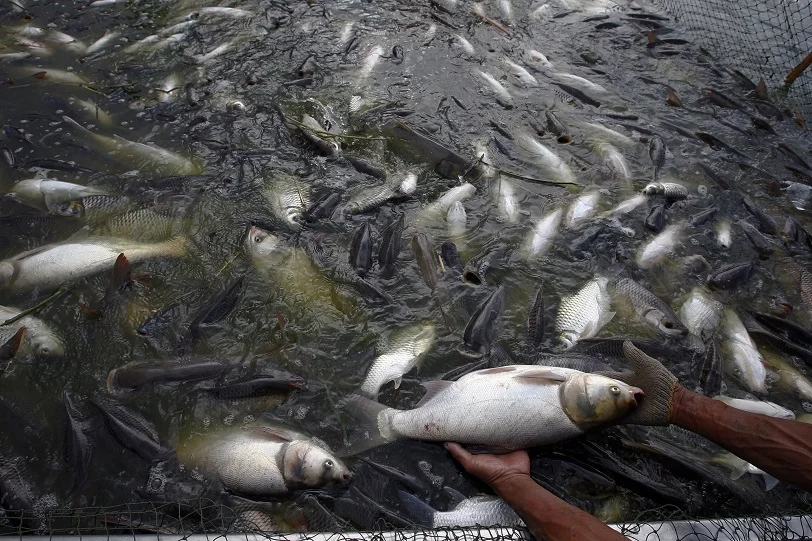
Kashmir houses a plethora of rivers, lakes, and fast running streams. An angler’s paradise, the valley is gifted with the alluring water bodies like Dal Lake, Wular Lake, Nageen Lake, Indus, Jhelum and snow-fed streams like the Sindh, Hipora, Aripal.
Kashmir provides ample opportunities for the development of fisheries. Fishing is a big business in Kashmir through spring and summer. Several species of fish like Schizothorax, Oreinus, Glyptothorax are characteristically Palearctic fish that have reached Kashmir across the Himalayas. Palearctic region comprises of terrestrial ecoregions of Europe, northern Himalayas in Asia, northern Africa and central parts of the Arabian Peninsula.
Johann Jakob Heckel, an Australian zoologist, found out that no fish of Indian plains could reach the valley since they have to cross through 30-miles of rapids and rocky gorges, concluding that the fish in the valley is completely different from the rest of India.
Schizothoracine fish or snow trouts locally known as Alegad inhabit both lentic (standing) and lotic (flowing) water bodies of Kashmir. Five species of snow trouts are present in the valley which include Schizothorax esocinus (Chirru) Schizothorax curvifrons (Satter gad), Schizothorax niger, Schizothorax plageostomus and Schizothorax labiatus.
The endemic fish have elongated and subcylindrical fleshy bodies and are known to be tastier and free of diseases. A pollution-free water body is characterized by the presence of snowtrouts.
Sunder Lal Hora, an ichthyologist, found out in his study that the origin and evolution of Schizothoracine occurred during the first interglacial period when turbulent streams were formed in Central Asia on account of the melting of ice.
In recent years Alegad has seen a rapid depletion in the valley. Heckel who visited Kashmir in 1838 reported 16 species of snowtrouts but at present only five species of the fish are found in the valley. Several man-made factors are responsible for the deterioration of the endemic species.
An internal study conducted by Wildlife Institute of India, Dehradun reported by Times of India has revealed, “Climate change will affect around 150 native fish species of the Himalayan states, including Uttarakhand, Himachal Pradesh, Jammu & Kashmir and Arunachal Pradesh.” Common snow trout, found in the Himalayan region and much sought after as a food fish, alone would lose around 21% of its existing space of 16,251 square kilometers, adds the study.
Brown trout introduced by the Britishers in Jammu & Kashmir in 1860 for fishing sports, has turned out to be a consequential threat to the snowtrouts. The nonindigenous breed is carnivorous and is found at high altitude in cold water unlike the endemic species which is herbivores and is found in cool water in mild altitude.
The increasing temperature forces Schizothorax niger move upward in search of food and that causes the conflict between the two species. The eggs and young ones of the snowtrouts become easy targets for the brown trout.
The introduction of exotic species like carp having prolific breeding, in Kashmir valley has resulted in a sharp decline of the native species. Carp was introduced in Kashmir in 1959 to accelerate fish yield, since then it has become the major commercial fish in the valley.
Excessive use of herbicides, pesticides, and fertilizers by the farmers results in eutrophication that is another major cause of the declining number of Alegad. Eutrophication is the excessive growth of nutrients on the surface of the water body which causes a dense growth of algae, blocking the sunlight from reaching the aquatic flora and fauna. Schizothoracine which survives in clean water finds it difficult to accommodate in such conditions resulting in heavy loss of the species.
Deforestation has led to a significant amount of eroded soil entering the water bodies and destroying the breeding ground for the fish.
During the spring season, lakes, rivers, and streams have an abundance of water due to the unprecedented melting of glaciers as a result of global warming. The fish try to go upstream and lay their eggs in shallow areas during spawning. Once the melting stops the water level decreases and the fingerlings are trapped, finding it difficult to go back to the mainstream.
Follow this link to join our WhatsApp group: Join Now
Be Part of Quality Journalism |
Quality journalism takes a lot of time, money and hard work to produce and despite all the hardships we still do it. Our reporters and editors are working overtime in Kashmir and beyond to cover what you care about, break big stories, and expose injustices that can change lives. Today more people are reading Kashmir Observer than ever, but only a handful are paying while advertising revenues are falling fast. |
| ACT NOW |
| MONTHLY | Rs 100 | |
| YEARLY | Rs 1000 | |
| LIFETIME | Rs 10000 | |











